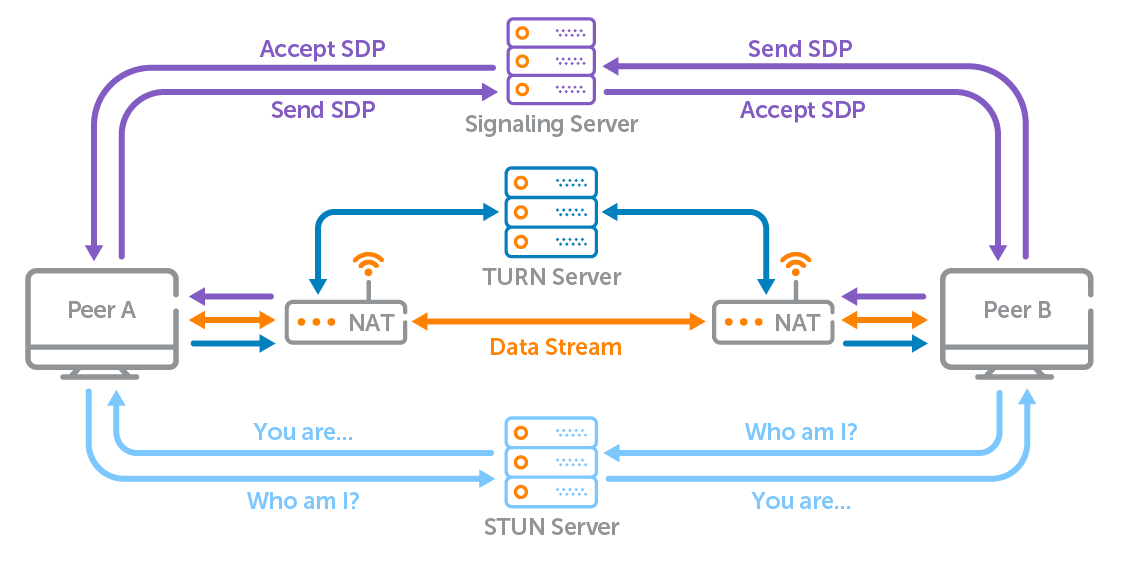
WebRTC: A Comprehensive Guide for Software Developers
WebRTC Overview
WebRTC, or Web Real-Time Communication, is an open-source project that enables browsers to directly exchange real-time media with other browsers in a peer-to-peer fashion
It allows for the efficient exchange of video and audio data, with a standardized API that supports browsers, mobile, and IoT devices
WebRTC Demystified
WebRTC relies on signaling servers to establish connections between peers. When a client wants to connect to another client (A wants to connect to B), both parties find out all possible ways the public can connect to them. They then signal this session information via other means, such as WhatsApp, QR codes, or WebSockets. Once they have established the most optimal path, they exchange their supported media and security options

NAT, STUN, TURN, ICE, SDP, and Signaling the SDP
WebRTC uses several key concepts to facilitate communication:
- NAT (Network Address Translation): NAT translates private IP addresses to public IP addresses, allowing multiple devices to share a single public IP
- STUN (Session Traversal Utilities for NAT): STUN servers allow clients to discover their public IP and port through the NAT
- TURN (Traversal Using Relays around NAT): TURN servers are used when symmetric NAT is present, as they relay packets between clients
- ICE (Interactive Connectivity Establishment): ICE collects all available candidates (local IP addresses, reflexive addresses, and relayed addresses) and sends them to the remote peer via SDP
- SDP (Session Description Protocol): SDP is a format that describes ice candidates, networking options, media options, security options, and other information
- Signaling the SDP: The SDP is sent to the other party using a signaling mechanism, such as WhatsApp, QR codes, or WebSockets
NAT Translations Methods
There are four types of NAT translations methods:
- One to One NAT (Full-cone NAT): Packets to external IP:port on the router always map to internal IP:port without exceptions
- Address Restricted NAT: Packets to external IP:port on the router always map to internal IP:port as long as the source address from the packet matches the table
- Port Restricted NAT: Packets to external IP:port on the router always map to internal IP:port as long as the source address and port from the packet match the table
- Symmetric NAT: Packets to external IP:port on the router always map to internal IP:port as long as the source address and port from the packet match the table, and only allow if the full pair matches
WebRTC Pros & Cons
Pros:
- P2P is great: Low latency for high bandwidth content
- Standardized API: No need to build your own
Cons:
- Maintaining STUN & TURN servers: Can be costly and time-consuming
- Peer 2 Peer falls apart in case of multiple participants: Not suitable for scenarios with multiple participants, such as Discord
More WebRTC Content
For more in-depth information on WebRTC, you can refer to the following resources:
WebRTC Under the Hood
To gain a deeper understanding of WebRTC, you can explore the following topics:
- Media API: Access microphone, video camera, and add tracks to a stream
- onIceCandidate and addIceCandidate: Maintain the connection as new candidates come and go
- WebRTC and SIP: Combine WebRTC and SIP for scalable, reliable communications applications
- WebRTC and WebSockets: Use WebSockets for real-time signaling with WebRTC
- WebRTC and IoT: Use WebRTC for real-time data exchange in IoT devices
- WebRTC and Security: Understand the security implications and best practices for WebRTC applications
Types of NAT Translations and Their Functionality with WebRTC
Network Address Translation (NAT) plays a crucial role in WebRTC by enabling devices with private IP addresses to communicate over the internet using public IP addresses. There are three main types of NAT translations:
- Static NAT:
- In Static NAT, each device is manually assigned a public IP address, which can be time-consuming and inefficient due to the scarcity of IPv4 addresses
- Dynamic NAT:
- Dynamic NAT automatically assigns public IP addresses from a pool of available addresses to devices, allowing multiple hosts to access the internet using a limited number of registered addresses
- PAT (Port Address Translation):
- PAT, also known as Port Address Translation, intelligently allocates only one public IP address to numerous private IP addresses by appending a unique port number to each private IP address
This method conserves IPv4 resources efficiently.
In the context of WebRTC, these types of NAT translations work in conjunction with protocols like STUN (Session Traversal Utilities for NAT) and TURN (Traversal Using Relays around NAT) to facilitate direct communication between peers behind different NAT configurations
STUN helps discover public IP addresses and router restrictions, while TURN acts as a relay when direct connections are not feasible due to symmetric NAT configurations
Understanding these NAT translation types is essential for optimizing WebRTC connections and ensuring seamless real-time communication over the internet.
Common Use Cases for WebRTC Technology
WebRTC, which stands for Web Real-Time Communication, is a versatile technology with various applications across different industries. Here are some common use cases for WebRTC:
- Real-Time Audio and Video Calling: WebRTC enables seamless audio and video communication between users, making it ideal for applications like video conferencing, customer support chat, and telemedicine
- Peer-to-Peer File Sharing: WebRTC facilitates fast and secure file sharing directly between users without the need for intermediaries, enhancing collaboration and data exchange efficiency
- In-Browser Customer Support Chat: Websites can integrate WebRTC for real-time customer support chats with features like screen sharing and annotations, improving user experience and service delivery
- Telemedicine Applications: WebRTC supports high-definition video/audio calls in telemedicine apps, allowing doctors and patients to communicate effectively and securely, including sharing health records
- Real-Time Gaming and Live Streaming: With low-latency streaming capabilities, WebRTC is utilized in gaming platforms like Google Stadia for immersive gaming experiences and live streaming applications
- Collaborative Tools: WebRTC powers collaborative tools with features such as live video/audio conferencing, document editing, and real-time communication, enhancing teamwork and productivity
- Entertainment and Audience Engagement: WebRTC is used in entertainment applications like augmented reality, virtual reality, gaming platforms, and live streaming services to engage audiences effectively
- IoT Devices Integration: IoT devices leverage WebRTC for real-time data exchange, enabling functionalities like live video/audio streaming from drones or surveillance cameras in scenarios such as home monitoring
These use cases demonstrate the versatility of WebRTC technology in enabling real-time communication, collaboration, and engagement across various sectors.
By delving into these topics and understanding the underlying concepts, you can harness the power of WebRTC to build efficient, real-time communication applications.

